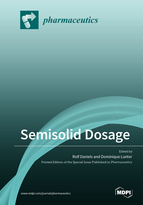Semisolid Dosage
A special issue of Pharmaceutics (ISSN 1999-4923).
Deadline for manuscript submissions: closed (31 December 2019) | Viewed by 58184
Special Issue Editors
Interests: semi-solids; oleogels; surfactant-free; foams; process analytical technology; electro-spinning
Special Issues, Collections and Topics in MDPI journals
Interests: semi-solid dosage forms; topical delivery; confocal Raman spectroscopy
Special Issues, Collections and Topics in MDPI journals
Special Issue Information
Dear Colleagues,
already in ancient times, semi-solid preparations for cutaneous application, popularly known as ointments, played an important role in human society. An advanced scientific investigation of “ointments” as dosage forms was set off in the late fifties of the previous century. It was only from then on that the intensive physico-chemical characterization of ointments as well as the inclusion of dermatological aspects was leading to a comprehensive understanding of the various interactions between the vehicle, the active ingredient and the skin.
From then on, many researchers were involved in optimizing semi-solid formulations with respect to the continuously changing therapeutic and patient needs. Aspects that have been dealt with were the optimization of dermato-biopharmaceutical properties and many different issues related to patient’s compliance, such as skin tolerance, applicability, and cosmetic appeal. Moreover, processing technology has been improved and analytical techniques were developed and refined in order to enable improved characterization of the formulation itself as well as its interaction with the skin.
This special issue serves to highlight and capture the contemporary progress and current research on semi-solid formulations as dermal drug delivery systems. We invite articles on all aspects of semi-solid formulations highlighting the research currently undertaken to improve and better understand these complex drug delivery systems in particular with respect to formulation, processing and characterization issues.
Prof. Rolf Daniels
Dr. Dominique Lunter
Guest Editors
Manuscript Submission Information
Manuscripts should be submitted online at www.mdpi.com by registering and logging in to this website. Once you are registered, click here to go to the submission form. Manuscripts can be submitted until the deadline. All submissions that pass pre-check are peer-reviewed. Accepted papers will be published continuously in the journal (as soon as accepted) and will be listed together on the special issue website. Research articles, review articles as well as short communications are invited. For planned papers, a title and short abstract (about 100 words) can be sent to the Editorial Office for announcement on this website.
Submitted manuscripts should not have been published previously, nor be under consideration for publication elsewhere (except conference proceedings papers). All manuscripts are thoroughly refereed through a single-blind peer-review process. A guide for authors and other relevant information for submission of manuscripts is available on the Instructions for Authors page. Pharmaceutics is an international peer-reviewed open access monthly journal published by MDPI.
Please visit the Instructions for Authors page before submitting a manuscript. The Article Processing Charge (APC) for publication in this open access journal is 2900 CHF (Swiss Francs). Submitted papers should be well formatted and use good English. Authors may use MDPI's English editing service prior to publication or during author revisions.
Keywords
- semi-solid
- dermato-biopharmceutics
- processing
- characterization
- quality control
- formulation concept
- rheology
- particle sizing
Related Special Issues
- Semisolid Dosage (Volume II) in Pharmaceutics (8 articles)
- Semisolid Dosage (Volume III) in Pharmaceutics (9 articles)








